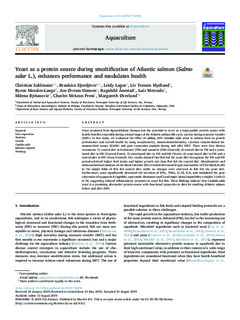| dc.contributor.author | Sahlmann, Christian | |
| dc.contributor.author | Djordjevic, Brankica | |
| dc.contributor.author | Lagos, Leidy | |
| dc.contributor.author | Mydland, Liv Torunn | |
| dc.contributor.author | Morales-Lange, Byron | |
| dc.contributor.author | Hansen, Jon Øvrum | |
| dc.contributor.author | Ånestad, Ragnhild | |
| dc.contributor.author | Mercado, Luis | |
| dc.contributor.author | Bjelanovic, Milena | |
| dc.contributor.author | Press, Charles McLean | |
| dc.contributor.author | Øverland, Margareth | |
| dc.date.accessioned | 2019-09-25T07:44:10Z | |
| dc.date.available | 2019-09-25T07:44:10Z | |
| dc.date.created | 2019-09-23T12:44:43Z | |
| dc.date.issued | 2019 | |
| dc.identifier.citation | Aquaculture, Volume 513, 15. November 2019, 734396 | nb_NO |
| dc.identifier.issn | 0044-8486 | |
| dc.identifier.uri | http://hdl.handle.net/11250/2618647 | |
| dc.description.abstract | Yeast produced from lignocellulosic biomass has the potential to serve as a high-quality protein source with health benefits, especially during critical stages of the Atlantic salmon life cycle, such as during seawater transfer (SWT). In this study, we evaluated the effect of adding 25% Candida utilis yeast to salmon feed on growth performance and overall health by using morphometry, immunohistochemistry, cytokine enzyme-linked immunosorbent assays (ELISA) and gene expression analysis during and after SWT. There were four dietary treatments: 1) control diet in freshwater (FW) and seawater (SW) (Control); 2) control diet in FW and a yeast-based diet in SW (Control/Yeast); 3) yeast-based diet in FW and SW (Yeast); 4) yeast-based diet in FW and a control diet in SW (Yeast/Control). Our results showed that fish fed the yeast diet throughout the FW and SW period achieved higher feed intake and higher growth rate than fish fed the control diet. Morphometric and immunochemical analyses of the distal intestine (DI) revealed decreased length and number of CD3 labeled cells in the simple folds of fish fed control diet, while no changes were observed in fish fed the yeast diet. Furthermore, yeast significantly decreased the secretion of IFNγ, TNFα, IL-1β, IL-8, and modulated the gene expression of aquaporin 8 (aqp8ab), superoxide dismutase (sod1) and major histocompatibility complex 1 (mhc1) in DI, suggesting reduced inflammatory processes in yeast fed fish. These findings indicate that Candida utilis yeast is a promising alternative protein source with functional properties in diets for smolting Atlantic salmon before and after SWT. | nb_NO |
| dc.language.iso | eng | nb_NO |
| dc.rights | Attribution-NonCommercial-NoDerivatives 4.0 Internasjonal | * |
| dc.rights.uri | http://creativecommons.org/licenses/by-nc-nd/4.0/deed.no | * |
| dc.title | Yeast as a protein source during smoltification of Atlantic salmon (Salmo salar L.), enhances performance and modulates health | nb_NO |
| dc.type | Journal article | nb_NO |
| dc.type | Peer reviewed | nb_NO |
| dc.description.version | publishedVersion | nb_NO |
| dc.source.volume | 513 | nb_NO |
| dc.source.journal | Aquaculture | nb_NO |
| dc.identifier.doi | 10.1016/j.aquaculture.2019.734396 | |
| dc.identifier.cristin | 1727793 | |
| dc.relation.project | Norges forskningsråd: 237841 | nb_NO |
| dc.relation.project | Norges forskningsråd: 239003 | nb_NO |
| cristin.unitcode | 192,10,1,0 | |
| cristin.unitcode | 192,16,1,0 | |
| cristin.unitname | Institutt for husdyr- og akvakulturvitenskap | |
| cristin.unitname | Institutt for basalfag og akvamedisin | |
| cristin.ispublished | true | |
| cristin.fulltext | original | |
| cristin.qualitycode | 1 | |

